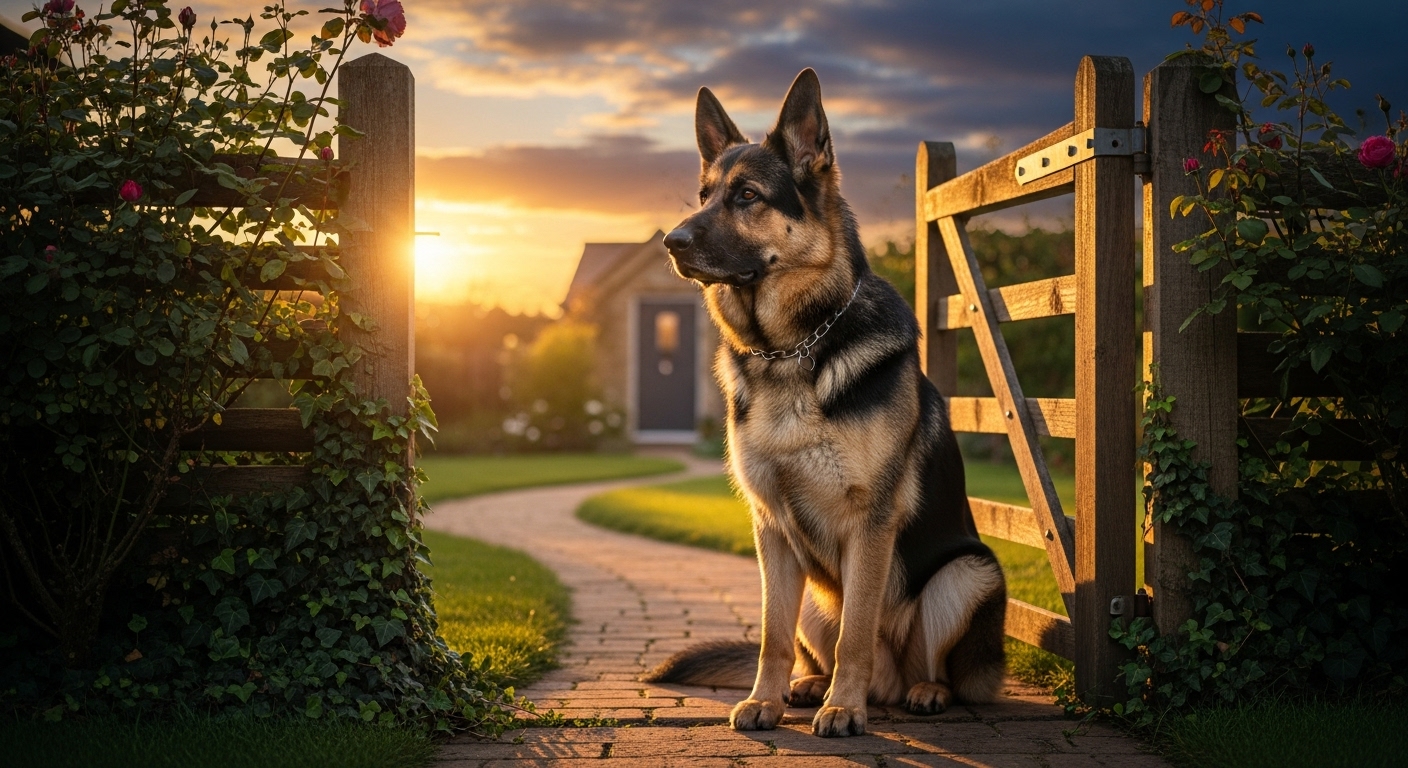
Check out our latest products
For centuries, humans have relied on dogs for protection — from guarding livestock to keeping homes safe. Even today, the sight of a large dog behind a fence or standing by its owner often sends a clear message: “Don’t try anything.” But does that perception hold true in reality?
Are big dogs genuinely effective crime deterrents, or is it more about appearance than ability? Let’s break down the science, psychology, and reality behind this enduring belief.
Why People Believe Big Dogs Deter Crime
The image of a large, barking dog guarding a property is deeply ingrained in our collective psychology. Big dogs — like German Shepherds, Rottweilers, and Mastiffs — are naturally associated with strength, alertness, and dominance.
This belief has several roots:
- Evolutionary instinct: Humans are hardwired to avoid potential threats, and large animals represent danger.
- Cultural reinforcement: Movies, media, and security imagery often show big dogs as protectors or police companions.
- Practical history: For centuries, large dogs were bred for guarding, herding, or hunting — all roles requiring courage and strength.
Even without formal training, a large dog’s presence alone can create hesitation in a potential intruder. But how much of that perception translates into actual prevention?
What the Research Says
Several studies and surveys have examined whether dogs — particularly large ones — reduce crime rates.
- University of North Carolina at Charlotte (Department of Criminal Justice): A 2017 survey of convicted burglars found that dogs were among the top deterrents, alongside security cameras and alarms. Most respondents said they would avoid homes where a dog was present, especially if it barked loudly or appeared large.
- Australian Institute of Criminology: Research suggested that properties with dogs had a lower risk of break-ins, regardless of breed, largely due to the unpredictability of dogs’ behavior and noise.
- Home Security Industry Insights: Studies show burglars prefer “quiet, low-visibility” homes. The sound or sight of a large dog breaks that profile.
While statistics confirm that dogs play a deterrent role, the key factor isn’t just size — it’s the visibility and behavior of the dog. Barking, movement, and alertness often matter more than the dog’s actual ability to fight off an intruder.
Big Dogs: Intimidation vs. Actual Protection
There’s an important distinction between deterring crime and stopping it.
A big dog can scare off potential criminals through intimidation. But in real-life situations, few large dogs are truly trained to defend physically. Most act as early warning systems — barking, alerting owners, and creating time to respond.
Behavior and Training Matter
Large breeds vary widely in temperament. For example:
- German Shepherds and Belgian Malinois are bred for guarding and police work, with high intelligence and loyalty.
- Rottweilers and Dobermans are confident, protective, and responsive to training.
- Great Danes or Newfoundlands, while large, are often gentle giants without guarding instincts.
A well-trained dog that responds to commands and maintains composure under stress is far more effective than an untrained large dog. Size alone doesn’t guarantee protection — temperament and obedience are key.
The Power of the Bark
Interestingly, noise may be a dog’s greatest crime deterrent.
A loud, consistent bark signals attention, ruins stealth, and draws witnesses — three things intruders try to avoid. Even medium or small dogs, if vocal and alert, can be surprisingly effective at discouraging trespassers.
Best Large Breeds for Home Protection
If protection is a priority, certain breeds naturally excel at deterrence. These dogs combine intelligence, loyalty, and courage with the right temperament for training.
1. German Shepherd
Highly intelligent and trainable, German Shepherds are the classic guard dog. They’re protective yet gentle with family, making them ideal for both companionship and security.
2. Rottweiler
Calm, confident, and fearless, Rottweilers have strong guarding instincts. When properly socialized, they are affectionate family pets and powerful deterrents.
3. Doberman Pinscher
Dobermans are fast, loyal, and highly responsive to commands. They bond closely with their families and excel in obedience and security roles.
4. Belgian Malinois
Similar to the German Shepherd but more agile, the Belgian Malinois is often used in police and military work. They’re energetic, loyal, and thrive with active owners.
5. Bullmastiff
Bred specifically for guarding estates, Bullmastiffs are quiet but incredibly protective. They rarely bark unnecessarily and are courageous without being aggressive.
6. Giant Schnauzer
This breed is intelligent and naturally protective. With proper training, Giant Schnauzers become loyal, alert watchdogs suited to both family and professional security roles.
These breeds are impressive guardians, but they also require significant mental stimulation, exercise, and socialization. Without proper training, even the best-intentioned big dog can become anxious, territorial, or difficult to control.
The Gentle Giants: Big Dogs That Aren’t Guarding Types
Not every large breed is suited for security — and that’s okay. Breeds like the Great Dane, Irish Wolfhound, Newfoundland, and Bernese Mountain Dog are affectionate, calm, and more likely to greet strangers than guard against them.
Their size might create a visual deterrent, but their personalities are often gentle and non-confrontational. These breeds are excellent family companions but shouldn’t be relied upon for home protection.
Factors That Influence Deterrence Beyond Size
1. Visibility
A visible dog — barking through a window or fenced yard — acts as a stronger deterrent than one kept indoors or unseen. Criminals tend to avoid unpredictable variables.
2. Environment
Warning signs (“Beware of Dog”), security lighting, and visible cameras amplify a dog’s deterrent effect. Together, they project an image of awareness and readiness.
3. Owner Behavior
Confident, responsible dog ownership enhances deterrence. A well-trained, well-cared-for dog signals vigilance — not neglect or aggression.
4. Training and Socialization
Dogs that are socialized properly learn to differentiate between genuine threats and harmless visitors. This prevents unnecessary aggression and ensures a balanced temperament.
Pros and Cons of Relying on a Big Dog for Security
Pros:
- Strong deterrent effect due to size and bark.
- Emotional comfort — many owners feel safer.
- Dual purpose: companionship plus protection.
- Increased awareness: dogs alert you before alarms do.
Cons:
- Maintenance and cost: large dogs require more food, space, and veterinary care.
- Liability: aggressive behavior or bites can create legal issues.
- Training demand: true guarding instincts require time and expertise.
- False sense of security: size alone isn’t foolproof protection.
Ultimately, big dogs can be part of a layered security strategy but should never replace practical measures like locks, alarms, and surveillance systems.
The Role of Training in Effective Deterrence
Trained dogs — even if not formally protection-trained — are the most reliable deterrents. Obedience training instills discipline, improves control, and strengthens the bond between dog and owner.
Simple commands like sit, stay, bark, and quiet can make the difference between a chaotic reaction and an effective deterrent response. Social exposure and regular exercise also help maintain a confident, balanced temperament — crucial traits for any dog serving as a guardian.
FAQs About Big Dogs and Crime Deterrence
Do barking dogs really prevent break-ins?
Yes, to an extent. Surveys of burglars consistently show that barking dogs — regardless of size — make properties less appealing targets.
Are small dogs effective deterrents too?
While small dogs can’t physically stop intruders, their alertness and loud barking provide an early warning system that can still discourage trespassers.
Can an untrained big dog protect a home?
Not reliably. Untrained dogs may bark or scare intruders away, but they can also become unpredictable or fearful under stress. Training greatly improves reliability.
Are guard dogs dangerous to families or children?
Properly bred and trained guard dogs are not inherently dangerous. Responsible ownership, early socialization, and consistent structure ensure they’re protective but safe.
What’s better for security — a dog or a home alarm system?
Ideally, both. Dogs offer deterrence and alertness, while alarms provide backup and 24/7 monitoring. Combined, they create a comprehensive security setup.
Final Thoughts
So, are big dogs really a good crime deterrent?
Yes — but only when the right factors come together. Their presence, bark, and confidence can make intruders think twice. However, size alone isn’t enough. The real effectiveness lies in a dog’s temperament, training, and the environment it lives in.
Big dogs are not just guardians; they’re companions that bring comfort, loyalty, and awareness to a home. When responsibly trained and cared for, they serve as both loving family members and watchful protectors — a combination that no alarm system can fully replicate.
Post Views: 314
Animal Wellness is North America’s top natural health and lifestyle magazine for dogs and cats, with a readership of over one million every year. AW features articles by some of the most renowned experts in the pet industry, with topics ranging from diet and health related issues, to articles on training, fitness and emotional well being.


![[PETHROOM] Cat Nail Clipper Trimmer for Indoor Cats with Circular Cut Hole (2mm) | Premium Sturdy Stainless Steel Blade Cat Claw | Safe, Easy, Accurate, Quiet & Fast | Avoid Overcutting](https://m.media-amazon.com/images/I/6156hi88deL._AC_SL1298_.jpg)
![[PETHROOM] Professional Eye Comb for Pets | Stainless Steel Tear Stain Remover for Cats & Dogs | Gentle Round-Head Grooming Tool | Compact & Portable for Eye Gunk Removal](https://m.media-amazon.com/images/I/71+W758uwXL._SL1500_.jpg)
![[petora] BRUSH ON ME Gentle Facial & Eye Comb for Dogs & Cats | Smooth & Stress-Free Tear Stain Remover | Fine-Tooth Grooming Tool with Rounded Tips | Comfortable Grip for Daily Pet Grooming](https://m.media-amazon.com/images/I/81hzVmjgV1L._SL1500_.jpg)









